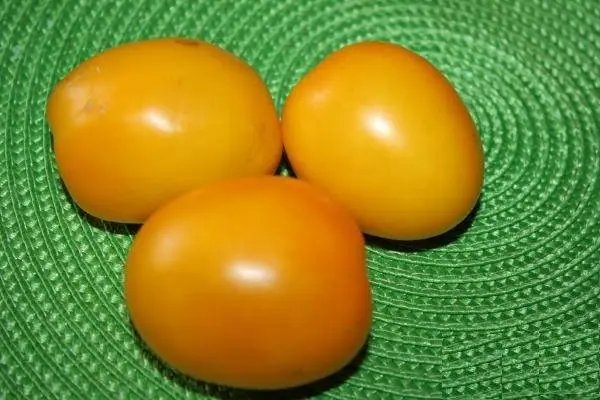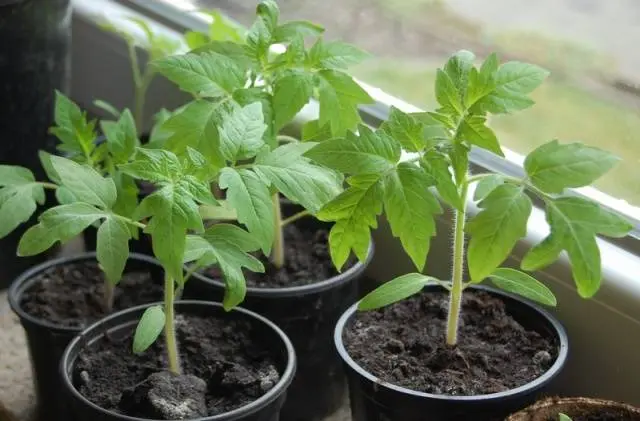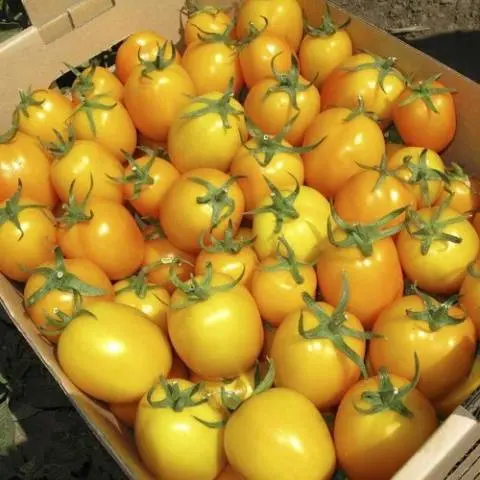Contents
Tomato Golden eggs is an early ripe variety bred by Siberian breeders. Bushes are compact and require minimal maintenance. The variety is suitable for growing in open areas, resistant to changing weather conditions and diseases.
Characteristics of a variety
Description of tomato Golden Eggs:
- early maturation;
- yield 8-10 kg per 1 square. m landings;
- bush height 30-40 cm;
- compact size of the plant;
- friendly ripening of fruits.
Features of the fruits of the variety Golden Eggs:
- weight up to 200 g;
- rich yellow color;
- elongated shape resembling an egg;
- good taste;
- absence of allergens in the pulp.
The variety is recommended for cultivation in areas without shelter. The fruits ripen on the bushes even under adverse conditions. After picking green tomatoes, they are stored at home for ripening.
According to reviews and photos, Golden Egg tomatoes have a universal application, they are suitable for preparing salads, appetizers, first and second courses. When preserved, they do not crack and retain their shape. The whitish pulp of the fruit does not contain allergens, so they are used for baby and diet food. From tomatoes get puree and juice.
Getting the seedlings
Tomato seeds Golden eggs are planted at home. Seedlings provide the necessary conditions and care. Plants are prepared for transfer to a permanent place.
Planting seeds
Seeds of the Golden Egg variety are planted in late February or March. Pre-prepared light fertile soil, fertilized with humus. The soil is harvested in the fall at a summer cottage or purchased ready-made land in a store. Tomatoes can be planted in peat tablets or cassettes.
The soil must be disinfected to eliminate pests and pathogens. It is heated for 30 minutes in the microwave. After processing, the soil is used after 2 weeks so that beneficial bacteria multiply in it.

Containers 15-18 cm high are filled with soil. When using large boxes, tomatoes will need a pick. Transplantation can be avoided by using individual cups with a volume of 0,5 liters.
For disinfection, the seeds are placed in a 1% solution of potassium permanganate for 20 minutes. Planting material is washed and planted in the ground.
Tomato seeds are planted to a depth of 0,5 cm. The containers are covered with foil and transferred to a dark place. Tomato germination occurs at temperatures above 20°C. When sprouts appear, the containers are rearranged on the windowsill.
seedling conditions
The development of tomato seedlings Golden eggs occurs when certain conditions are met:
- daytime temperature from +23 to +25°С;
- night temperature +16°С;
- daylight hours 12-14 hours;
- watering with warm water.
The room with planting tomatoes is regularly ventilated, but the plants should not be exposed to drafts.
The length of daylight hours is increased by backlighting. At a distance of 30 cm from the seedlings, fluorescent lamps or phytolamps are installed.
The soil is watered with settled water. It is best to use a spray bottle. When watering, make sure that water does not fall on the leaves of plants.
After the appearance of 2 leaves in tomatoes, they swoop down in separate containers. Weak and elongated seedlings are eliminated. After picking, tomatoes are watered every week.
In April, Golden Eggs begin to harden tomatoes. First, a window is opened for 2-3 hours, then the containers with plantings are transferred to the balcony. Gradually, the tomatoes will get used to natural conditions and will more easily endure planting in a greenhouse or open ground.

Landing in the ground
Tomatoes Golden eggs are transferred to a permanent place in May. Seedlings should reach 30 cm in height and also have 6-7 leaves.
The variety is grown both in open ground and under cover. A higher yield is obtained when planting tomatoes in a greenhouse or greenhouse. In Siberian conditions, the variety ripens in open areas. Tomatoes prefer light soil and places well lit by the sun.
The soil for tomatoes is prepared in the fall by digging and introducing humus. To increase soil fertility, add 20 g of potassium salt and superphosphate. In the spring, it is enough to carry out deep loosening.
It is not recommended to plant tomatoes after tomatoes, potatoes, peppers, eggplants. In a greenhouse, it is better to completely replace the topsoil.
Holes are dug in the garden, where tomatoes are transferred, keeping an earthen clod. For 1 sq. m place no more than 4 plants. The roots are covered with earth, after which the tomatoes are watered. The next 7-10 days do not add moisture or fertilizer to allow the tomatoes to adapt to the changed conditions.
Variety care
The fruiting of tomatoes depends on the supply of moisture and nutrients. According to reviews, Golden Egg tomatoes are unpretentious in care and do not need pinching. Undersized bushes are tied at the top to a support.
Watering plants
Tomatoes are watered once or twice a week, taking into account weather conditions and the stage of their development. Pre-defend water in barrels, and bring it in the morning or evening.
Watering scheme for tomatoes Golden eggs:
- before the formation of buds – every 3 days with 3 liters of water per bush;
- during the flowering period – weekly, 5 liters of water;
- when fruiting – twice a week, 2 liters of water.
A sign of a lack of moisture is yellowing and twisting of the tops. With insufficient moisture, the inflorescences begin to fall off. Excess moisture slows down the development of tomatoes and provokes the development of diseases.
After watering, the soil is loosened to a depth of 5 cm so as not to damage the roots of the tomatoes. Mulching with peat or straw will help maintain soil moisture.

Application of fertilizers
Tomatoes are fed with organic or mineral substances. During the season, 3-4 treatments are carried out.
For the first feeding, slurry in the amount of 0,5 liters is required. It is added to a 10-liter bucket of water, and the resulting solution is poured over tomatoes under the root. The consumption of funds for each plant is 1 liter.
When forming ovaries, tomatoes are treated with a solution based on phosphorus and potassium. Phosphorus is responsible for the transport of nutrients in the plant body and the development of the root system. The final taste of tomatoes depends on potassium.
An effective way to feed is to spray the tomatoes on the leaf. To prepare a solution for foliar treatment, components with phosphorus and potassium are taken in an amount of 10 g each.
Between processing tomatoes make a gap of 2-3 weeks. You can replace minerals with wood ash.
Protection against diseases and pests
According to the description, Golden Egg tomatoes remain resistant to major crop diseases. To protect plantings from late blight, they are treated with Ordan. On its basis, a solution is prepared, which is sprayed on the plants on the leaf. Processing is carried out every 10-14 days and stopped 20 days before fruit collection.
When attacked by pests, the aerial part of the tomatoes is damaged and the yield is reduced. Insecticides are used against insects. From folk remedies, dusting with tobacco dust is effective, watering with garlic and onion infusions.
Reviews of gardeners
Conclusion

Tomatoes of the Golden Egg variety are suitable for children’s and diet food. The variety is unpretentious and gives a high early harvest even in adverse conditions. Tomatoes are cared for by watering and fertilizing. To protect against diseases, preventive spraying of tomatoes is performed.










samahani jamani nataku kujua aina ya mbegu ya dhahabu ni ya aina gani jaman?